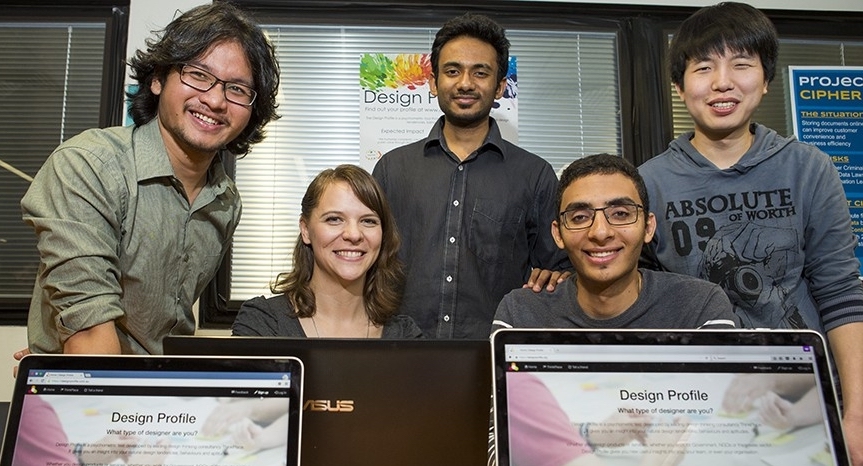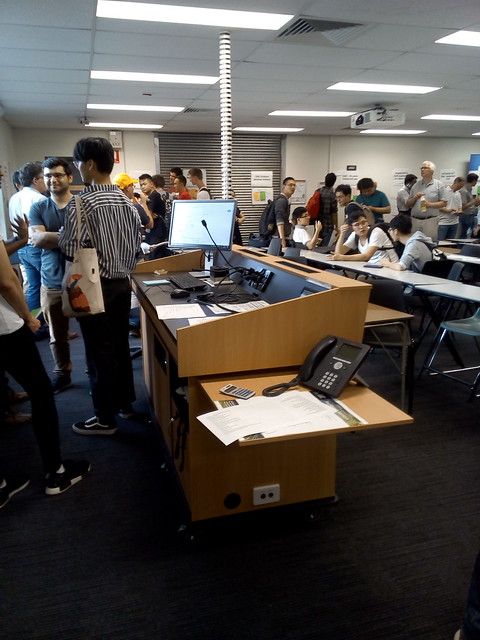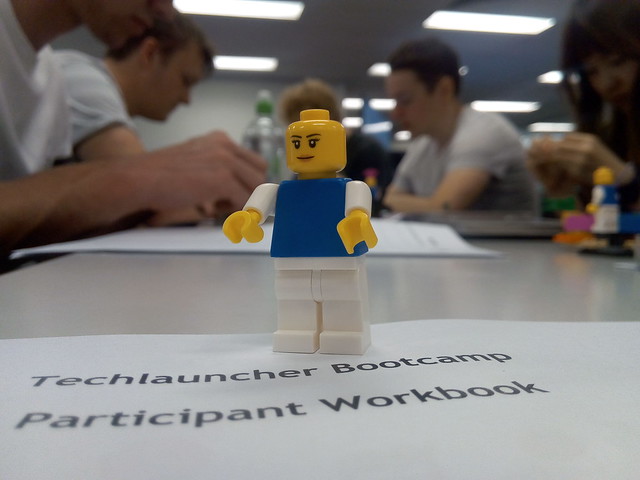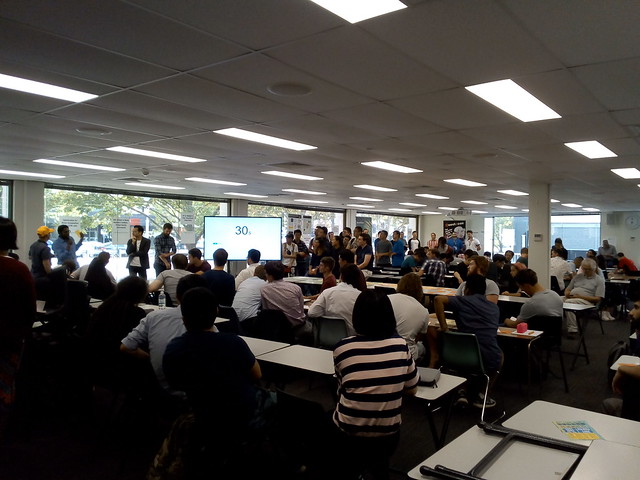- Energy use and Carbon Emissions
- New Flexible Classrooms
- E-learning
Friday, August 31, 2018
Decreasing Campus Energy Use With Flexible Classrooms and e-Learning
I will be speaking on "Decreasing Campus Energy Use With Flexible Classrooms and e-Learning" at EduBuild 2018 in Singapore, 9 October, 5:20pm. This is a new part of the annual EduTech conference, focusing on classroom design and use.
Thursday, August 30, 2018
Blockchain for Microcredentials
Greetings from the Australian Computer Society (ACS) in Sydney. I am a member of the ACS Blockchain Technical committee and taking part in a workshop with people from industry and academia. We were looking for use cases, so I suggested education, specifically blockchain for micro-credentials.
Educational qualifications much shorter than current diplomas and degrees is a hot topic in Australian vocational and higher education. What takes this beyond a theoretical discussion is New Zealand recognizing Micro-credentials from 22 August 2018.
A NZ micro-credential is equivalent to about 1 to 8 weeks study. So in addition to accumulating perhaps a half dozen macro-credentials during their career, an individual may have hundreds of micro-credentials. It would be cumbersome to manage these on paper, or through a centralized computer system.
The micro-credentials may then be automatically checked for some jobs by automated systems. I will touch on this in my talk on mobile education for the Computer Society of Sri Lanka National IT Conference (NITC 2018), 2 to 4 October. Students could study and be tested via their mobile device and then their digital certificate provided via the same device.
Educational qualifications much shorter than current diplomas and degrees is a hot topic in Australian vocational and higher education. What takes this beyond a theoretical discussion is New Zealand recognizing Micro-credentials from 22 August 2018.
A NZ micro-credential is equivalent to about 1 to 8 weeks study. So in addition to accumulating perhaps a half dozen macro-credentials during their career, an individual may have hundreds of micro-credentials. It would be cumbersome to manage these on paper, or through a centralized computer system.
The micro-credentials may then be automatically checked for some jobs by automated systems. I will touch on this in my talk on mobile education for the Computer Society of Sri Lanka National IT Conference (NITC 2018), 2 to 4 October. Students could study and be tested via their mobile device and then their digital certificate provided via the same device.
Monday, August 27, 2018
Learning to be a Professional
 |
‘Design Profile’. Photo by Stuart Hay |
It is a little daunting walking into a classroom mid-semester with a room full of experienced students who have bonded into teams. So I decided to treat it like a job application, and put up on screen my LinkedIn profile. The students were not that impressed with my past work, as much of it is from before they were born. However, there were interested in my 700+ contacts, and asked how does someone starting out get these. My answer was that they need to gain experience outside their their course and that will be assessed in their last assignment.
This was a little off topic for the tutorial, which was supposed to be about hearing from them where their projects are up to. However, I pointed out that the Work Portfolio Package, their last assessment item (worth 20%), requires them to write a job application and provide evidence of how professional they are. A large part of being professional is learning to learn, and learning to work with people.
A previous version of ANU Techlauncher required a reflective portfolio, where students commented on their learning. However, this is a very abstract concept to get across to students generally. It is particularly difficult for STEM students to understand the relevance of reflection (it is easier for educators from a social science). I still have difficulty with reflection, even after successfully completing a portfolio for an MEd capstone, for fellowship of the Higher Education Academy and most recently for the ANU Technology-Enhanced Learning in Higher Education Certificate.
For TechLauncher, the reflection was recast as a job application. The student has to explain how their experience during the course is relevant to a real job. This is essentially the same learning reflection exercise, but in a format which is very relevant to a final year student who will soon need a job. What many students have difficulty with is that this is not just about what they learned as part of the course content, but what they sought out to learn externally.
To make the need for reflection explicit, the marking criteria for the portfolio are about the student's professional approach: evidence of decision-making, maturity of reflection, professional tone, evidence of life-long learning, acting on feedback and professional attitude.
Of the criteria, evidence of life-long learning, causes the most difficulty. Having been the recipients of carefully curated education for years, students have difficulty with the idea of seeking out learning for themselves. The usually response is "Can we just watch some YouTube videos?". The assumption is that any more structured learning is something where they have to pay someone to tell them what to do.
Students, I suggest, need to be shown how to go out and find learning for themselves. They also need to be told it is okay if this is outside their discipline, provided their is some relevance (such as soft skills). At and around universities there are many learning opportunities, some formal, some informal. What the student needs to do is work out what they want to learn, what is available for that, how they will know they learned something, and in professional terms, what evidence will they have to show an assessor, or employer, that they learned.
At least that is what I tried to get across to the students in the tutorial last week. Just watching some videos what not enough. They had to first work out what they needed to learn, then decide if the videos were suitable, then decide if they had really learned, and lastly provide some documentation of this. As a certified computer professional I am required to do 30 hours of such training per year, with evidence and possible audit of my claims.
Finding extra learning at a university and particularly in a university city such as Canberra, is not that difficult. There are free and low cost courses run by the universities and affiliated bodies, such as the Canberra Innovation Network. There are university clubs and societies, such as the ANU Computer Science Student Association. Student membership of professional bodies, such as the Australian Computer Society and Engineers Australia. provides the opportunity to not only attend events, but also take part in running them. The professional contacts come as a by product of these activities, from meeting people.
Saturday, August 25, 2018
Teaching and Research Jobs at ANU in Computer Science
 |
| New ANU Maths & Computer Science Building |
 Wednesday, August 22, 2018
Wednesday, August 22, 2018ANU Technology-Enhanced Learning in Higher Education Certificate
This week I received my ANU Technology-Enhanced Learning in Higher Education Certificate. This required completing ten short online "ANU Coffee Courses"
and a 500 word reflection.
Innovation ACT
ANU Social Enterprise Bootcamp
ANU Project Bootcamp with Lego and User Centered Process
On Saturday I participated in the TechLauncher "Bootcamp" at
the Australian National University in Canberra. There were about
three hundred students who had been formed into about fifty teams of six students each, after Thursday night's team formation exercise. Each team has a tutor and a client, plus there as some mentors to help teams in areas such as social enterprises.
Team Formation Exercise in ANU Large Flat Floor Classroom
Greetings from the TechLauncher Team Formation event at
the Australian National University in Canberra. There are more than
three hundred students hearing 30 second pitches from potential clients.
The students then select the project they prefer and form a team. They
have a year to build what the client wants, which is usually software,
but could be engineering hardware.
Wednesday, August 22, 2018
ANU Technology-Enhanced Learning in Higher Education Certificate
 This week I received my ANU Technology-Enhanced Learning in Higher Education Certificate. This required completing ten short online "ANU Coffee Courses" and a 500 word reflection. As with previous such courses I found the difficult part was to keep up the work week after week and then try to make sense of it all in the reflection. This was a pilot program and there may be some changes before it is offered more widely.
This week I received my ANU Technology-Enhanced Learning in Higher Education Certificate. This required completing ten short online "ANU Coffee Courses" and a 500 word reflection. As with previous such courses I found the difficult part was to keep up the work week after week and then try to make sense of it all in the reflection. This was a pilot program and there may be some changes before it is offered more widely.
The notes from the ANU Coffee Courses are available online. Here are the ones I completed:
| Code | Course | Length |
|---|---|---|
| AOC003 | Engaging students online | 1.5 Hours |
| AOC004 | Open Educational Practice | 2 Hours |
| AOC006 | Enhancing your lectures | 2 Hours |
| AOC007 | Virtual Reality-Imagining new educational reality | 2 Hours |
| AOC008 | Video in Teaching and Learning: Why video? | 2 Hours |
| AOC009 | Video in Teaching and Learning: Creating videos | 2 Hours |
| AOC010 | Open Education: From Resources to Practice | 2 Hours |
| AOC011 | Build your researcher profile | 1 Hour |
| AOC012 | Getting Started with ePortfolios | 1.5 Hours |
| AOC013 | Fostering student wellbeing | 1 Hour |
| AOC014 | Deep and Interactive Learning in lectures | 1 Hour |
| AOC015 | Group and collaborative learning | 2 Hours |
| AOC017 | Peer assessment and feedback | 1 Hour |
| AOC018 | Designing Online Learning Environments | 1 Hour |
Tuesday, August 21, 2018
Online Courses Offered by Australian Universities
In thinking about how Australian higher education might offer blended courses to the region, I decided to look at what is already available. One interesting option is the edX "micromasters" offered by four Australian universities:
Australian universities also offer some online degrees and online versions of campus courses, to their own students and those of other institutions. As an example, the ANU offers twelve undergraduate language subjects through Open Universities Australia. In total ANU offers 116 online courses, of these 30 are undergraduate.
- Australian National University: Evidence-Based Management
- Curtin University: Human Rights,Marketing in a Digital World, Internet of Things (IoT),
- UQ: Business Leadership, Corporate Innovation, Sustainable Energy, Leadership in Global Development
- University of Adelaide: Big Data
Students undertake a series of online courses and then may
undertake some form of capstone project. Students are offered 25% credit (one semester
full time study) towards a Masters, subject to an additional test. This makes the micromasters similar in level and length to an Australian university graduate certificate. However, the micromasters, despite the name, is not itself a qualification under the Australian Qualifications Framework.
Australian universities also offer some online degrees and online versions of campus courses, to their own students and those of other institutions. As an example, the ANU offers twelve undergraduate language subjects through Open Universities Australia. In total ANU offers 116 online courses, of these 30 are undergraduate.
Training Tech Professionals to Teach: Part 9
In Part 8 I decided the task of designing an entire qualification in teaching for computer professionals is perhaps a bit too
much. But what quantum is reasonable? What is the current practice at Australian universities to teach those who teach?
Those being prepared to teach at the University of New South Wales (UNSW) are asked to do 16 hours study over 8 weeks in the blended course "Beginning to Teach". This is aimed at Higher Degree Research (HDR) candidates (mostly PhD students) and Early Career Researchers (ECRs who already have a PhD), and who are expected to teach:
The UNSW Foundations course is aligned with their Graduate Certificate in University Learning and Teaching (GCULT). The Foundations course makes up part of the content of the first part of the certificate.
Given that technology enabled learning is now widely adopted, it would seem reasonable to incorporate this in basic teacher training. That is, rather than teaching classroom "chalk and talk" first and then the technology as an afterthought, do it the other way around. I suggest teaching online techniques as basic teaching methods and classroom face-to-face as a variation of that.
Those being prepared to teach at the University of New South Wales (UNSW) are asked to do 16 hours study over 8 weeks in the blended course "Beginning to Teach". This is aimed at Higher Degree Research (HDR) candidates (mostly PhD students) and Early Career Researchers (ECRs who already have a PhD), and who are expected to teach:
For UNSW teaching staff there is the more advanced "Foundations of University Learning and Teaching Program" (FULT). This consists of 4 modules, 10 hours study per module, over 2 to 3 weeks per module:From "Beginning to Teach", UNSW, 2018.
- "Demonstrate understanding of some key elements of learning and how they relate to teaching and to their disciplinary context.
- Plan, facilitate and evaluate a short teaching session that aligns aims and approach with outcomes.
- Give and receive feedback to colleagues regarding teaching and to students regarding assessment of learning."
Curiously, the beginning and foundations courses do not appear to be aligned or nested. The assumption appears to be that all those who are teaching at university undertook basic teacher training as part of a higher degree or post-doctoral training. This assumes a traditional academic career which is increasingly rare and excludes those with non-research degrees and industry experience. A better approach perhaps would be to have the beginning course available to anyone new to teaching, not just HDRs and ECRs. That course would then form the first module of the foundation course.
- "Student Learning and Teaching
- Educational Design
- Assessment and Feedback
- Reflection and Evaluation"
The UNSW Foundations course is aligned with their Graduate Certificate in University Learning and Teaching (GCULT). The Foundations course makes up part of the content of the first part of the certificate.
UNSW also offer a "Learning to Teach Online" course via Coursera, 3 hours per week, over 6 weeks. This appears to be designed for teachers generally, not specifically for university teachers, or those at UNSW:
"Module 1 Why is Online Teaching ImportantAthabasca University offers a similar on-line course "Technology-Enabled Learning", 3 hours per week, over 5 weeks. There is an earlier set of course materials available under a Creative Commons license.
Module 2: Open and Institutionally Supported Technologies
Module 3: Planning Online Learning
Module 4: Online Learning Activities
Module 5: Online Assessment Strategies
Module 6: Online Resources
Module 7: Engaging and Motivating Students
Module 8: Evaluation Strategies"
Given that technology enabled learning is now widely adopted, it would seem reasonable to incorporate this in basic teacher training. That is, rather than teaching classroom "chalk and talk" first and then the technology as an afterthought, do it the other way around. I suggest teaching online techniques as basic teaching methods and classroom face-to-face as a variation of that.
Sunday, August 19, 2018
Quickly Constructing University Buildings from Timber
 |
| ANU Timber Student Building Construction |
"The Union Court Redevelopment project includes a 450 bed student accommodation and 7,000 m2 teaching building to be built using cross laminated timber (CLT) and glulam (GLT).
Mass Timber in the form of Cross Laminated Timber and Glulam has finally come to Canberra, with the recent redevelopment occurring within the campus of the Australian National University.Lendlease DesignMake, the designer and fabricator of the engineered timber structures for this project will discuss the design and construction of this redevelopment. Other speakers will discuss mass timber use, CLT and fire rating of timber. The seminar will also include a guided walk to view the actual construction on the ANU site.
This half-day seminar is a must for all building and design professionals including architects, engineers, building designers, certifiers, developers, builders, regulators and educators. ...
Program
12.30pm Welcome
- Welcome and WoodSolutions Update and Mass Timber - Andrew Dunn, TDA
- Building’s use in Australia to date
12.45pm Union Court, ANU
- Design and Construction of Union Court
- Student Accommodation and Teachers Facility - Andrew Smith, DesignMake
- Guide walk to building site - Andrew Smith, DesignMake
03.00pm Afternoon tea and coffee break03.30pm Mass Timber Solutions05.00pm Finish"
- CLT Design and Fabrication insight - Sean Bull, XLAM
- Mould & Fire = Destructive Forces & Solutions for Mass Timber - Andreas Luzzi, Laros Indust.
- Calculating Timber Charring Rates and AS1720.4 Update - Andrew Dunn, TDA
From: "Mass Timber (CLT) Building Free WoodSolutions Seminar"
ps: I will be speaking on "Learning to use new tech-infused teaching spaces" at EduBuild 2018 in Singapore, 9 October, 5:20pm.
Saturday, August 11, 2018
New Zealand to Recognize Micro-credentials from 22 August 2018
The New Zealand Qualifications Authority (NZQA) proposes to recognise micro-credentials from tertiary education organizations from 22 August 2018. This follows a consultation paper and feedback.
What is not clear to me is how micro-credentials will fit with existing university and vocational education and training (VET) qualifications. The NZ micro-credential is 5 to 40 NZ "credits", where a year full-time study is 120 credits. This make a NZ micro-credential is about one hundredth, to one tenth, of a three year degree, making it a deci- or centi-credential (a literal "micro-credential" would be about 30 minutes study).
In the Australian system a common sub-degree qualification is a "certificate" (or graduate certificate) requiring half a year study. This would make a NZ micro-credential between 8% and 67% of a certificate. An Australian university year is commonly 24 weeks of study, making a NZ micro-credential equivalent to 1 to 8 weeks study. An Australian VET Certificate IV requires ten "Units of competency". So a NZ micro-credential would be between half and four units of competency.
Micro-credentials may well "disrupt" the higher education system, by providing shorter, cheaper, more convenient and relevant qualifications. Hopefully this can be done with protection for the students, teachers and the community, from exploitation. It needs to be kept in mind that qualifications are not just about students getting a better job, they are about ensuring the community receives the safe level of service expected.
Australia has experienced exploitation of students in vocational courses, where they were signed up for overpriced worthless qualifications, and exploitation of students in the "gig-economy" workforce, where they were underpaid (and threatened if they spoke out). If not carefully regulated, micro-credentials could create perfect conditions for further exploitation of students.
What is not clear to me is how micro-credentials will fit with existing university and vocational education and training (VET) qualifications. The NZ micro-credential is 5 to 40 NZ "credits", where a year full-time study is 120 credits. This make a NZ micro-credential is about one hundredth, to one tenth, of a three year degree, making it a deci- or centi-credential (a literal "micro-credential" would be about 30 minutes study).
In the Australian system a common sub-degree qualification is a "certificate" (or graduate certificate) requiring half a year study. This would make a NZ micro-credential between 8% and 67% of a certificate. An Australian university year is commonly 24 weeks of study, making a NZ micro-credential equivalent to 1 to 8 weeks study. An Australian VET Certificate IV requires ten "Units of competency". So a NZ micro-credential would be between half and four units of competency.
Micro-credentials may well "disrupt" the higher education system, by providing shorter, cheaper, more convenient and relevant qualifications. Hopefully this can be done with protection for the students, teachers and the community, from exploitation. It needs to be kept in mind that qualifications are not just about students getting a better job, they are about ensuring the community receives the safe level of service expected.
Australia has experienced exploitation of students in vocational courses, where they were signed up for overpriced worthless qualifications, and exploitation of students in the "gig-economy" workforce, where they were underpaid (and threatened if they spoke out). If not carefully regulated, micro-credentials could create perfect conditions for further exploitation of students.
From: "Recognising micro-credentials in New Zealand", NZ, 2018
"Micro-credentials Characteristics Educational elements
- Certifies achievement of a set of skills and knowledge
- Coherence of the skills and knowledge required
- Purpose statement required
- Learning outcomes required
- Strong demonstrable evidence of need by industry, employer and/or community required
- Does not typically duplicate current quality-assured learned approved by NZQA
Credit values 5 to 40 credits Entities who may deliver or arrange training
- Tertiary education providers and Industry Training Organisations can seek approval of micro-credentials through the training scheme rules and consent to assess rules
- Non-Tertiary Education Organisations (TEOs) - Equivalency service only
Administration
- Yearly review of quality-assured micro-credentials
- Quality-assured micro-credentials published on a public register
- Micro-credentials with an equivalence statement (delivered by non-TEOs) published on a separate register"
Friday, August 10, 2018
Innovation ACT
InnovationACT
is a ten week startup
program and completion for Canberra's university students (with a $50,000 seed pool). IACT starts 14th August. I am one of the mentors (my team last year was OK RDY).
Thursday, August 9, 2018
ANU Innovation in Teaching Showcase
The Australian National University is holding the 2018 CAP – CASS Innovation in Teaching Showcase in Canberra, 4 & 5 September. The ANU College of Asia and the Pacific, and the College of Arts and Social Sciences will discuss teaching innovations. Highlights include ANU language courses with Open Universities Australia. The event is free and all teachers and academics are invited to register through Eventbrite.
Wednesday, August 8, 2018
Learning to use new tech-infused teaching spaces
 |
| ANU "TechLauncher" in flat floor classroom. |
"Teachers and students will need to learn to use new flexible classrooms.ps: The day before at EduBuild I will be speaking on "Decreasing Campus Energy Use With Flexible Classrooms and e-Learning".
This will require blending the physical spaces with online tools and techniques. Both staff and students will need to work together, with team teaching and group learning.
- How do we get teachers to use these new spaces for more than old fashioned "chalk and talk"
- How can physical spaces be integrated with flipped, blended and online courses?
- How can these spaces fostering student engagement?
- How do these spaces promote collaborative and peer learning?
- What curriculum changes are needed to promote effective use of new teaching spaces?
- Can the new teaching spaces also be innovation centers?
- Do teachers, and university academics, need new formal qualifications to teach in these spaces?"
Thursday, August 2, 2018
Computer Professionals Providing Mobile Learning for the Digital Economy
My topic is "Computer Professionals Providing Mobile Learning for the Digital Economy". I suggest that teaching is an under-recognized skill for computing academics, they can be trained using mobile learning, and use it for teaching. There is a short promotional video and here are some notes:
Computer Professionals Providing Mobile Learning for the Digital Economy
by Tom Worthingtonfor NITC 2018, October, Colombo
IT Professionals Change Everything
IT developments depend on trained computer professionals to make them happen.
Example: Async-Sync Learning System being built at ANU.
Drive the Digital Economy Through Education
Education is an under-recognized specialist area for computer professionals.
Example: Free open online ICT Sustainability Course, delivered via the open source Moodle Learning Management System, by ACS, ANU, and Athabasca University for the last ten years.
Changes Needed in Education
- Qualify computer professionals as education specialists at higher education institutions.
- Accelerate their training, using mobile learning.
- Have these professionals design and deliver mobile learning.
- Teach these techniques to educators in other disciplines and other education systems.
Key Metrics
What proportion of your computer educators are dual qualified in computing and education?
What proportion of your computer education courses are offered on-line via mobile devices?
Register Now
NITC 2018, Colombo
2 to 4 October 2018
http://www.nitc.lk/2018/
2 to 4 October 2018
http://www.nitc.lk/2018/
Subscribe to:
Comments (Atom)

